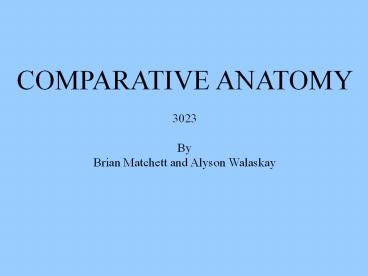COMPARATIVE ANATOMY PowerPoint PPT Presentation
1 / 32
Title: COMPARATIVE ANATOMY
1
COMPARATIVE ANATOMY 3023 By Brian Matchett and
Alyson Walaskay
2
WHAT IS COMPARATIVE ANATOMY?
3
(No Transcript)
4
Comparative Anatomy
- The study of and comparison of body parts of
different species
5
Comparative Anatomy Includes
- Change, adaptation, and mutation of species
- The invasion of new territories
- Species compatibility with surroundings
6
How Can Comparative Anatomy Help Us?
- Understand our history
- Consider plans for change
- Improve animal genetics
- Preserve endangered species
7
Why Should We be Aware of Comparative Anatomy?
- Variations in care for animals
- Differences in animal habits
8
Adaptation
- Genetic and physiological changes that occur due
to pressures or changes in an animals environment
9
Adaptation Changes
- Examples
- Forelimb of humans used for manipulating
- Webbed foot of seal used for swimming
- Front feet of a mole used for digging
10
Structural Development
- Homologous Structures
- Analogous Structures
11
Homologous Structures
- Have similar structures, but different uses
- E.g. Turtle leg
- and bird wing
12
Analogous Structures
- Body parts similar in use, but different in
structure - E.g. Bird wing and insect wing
13
Directional Terms
- Used to describe the positions of structures on
the body relative to other structures or locations
14
Cranial closer to the head of the
animal Caudal closer to the tail Medial
closer to the midline of the limb, trunk or
head Lateral farther away from the midline
15
(No Transcript)
16
Dorsal close rot the top side (back) of the
animal Ventral closer to the bottom side
(belly) of the animal Proximal closer to the
attachment of the appendage to the body Distal
farther away from the attachment of the body
17
Comparative Anatomy of Typical Farm Animal
Species Includes
- Skeletal Structures
- Reproduction
- Digestive Systems
18
(No Transcript)
19
Skeletal Structures
- Protects vital organs and gives basic form and
shape to an animals body
20
Reproduction
- The production of live, normal offspring
21
(No Transcript)
22
Puberty age at which reproductive organs become
functionally operative Gestation time from
breeding or conception of a female until she
gives birth to her young Estrus time for
acceptance of the male and normally coincides
approximately with ovulation Heat Estrous
Cycle Estrus cycle or the time from one estrus
to the next
23
Digestion
- Includes all the organs that are involved in the
digestion of food
24
(No Transcript)
25
Types of Digestion
- Monogastric or Simple Stomach
- Ruminant
- Avian
26
Monogastric
- Characterized by the inability to digest roughage
efficiently - Enzymes used to break food down
- Includes humans, swine, rabbits and horses
27
(No Transcript)
28
Ruminant
- Handles the breakdown of large amounts lignified
fiber - Has four different compartments
- Rumen - Omasum
- Reticulum - Abomasum
- Includes sheep, cows, goats
29
(No Transcript)
30
Avian
- Designed for grinding hard or encased food
- Has a gizzard
- Have no teeth
- Includes all birds
31
WEB CITATIONS
- BSC Courseware http//tidepool.st.usm.edu/crsw
r/homologousstructs.html - Homologous Structures http//www.kent.wednet.edu/
staff/rlynch/sci_class/chap06/homologous.html
32
WEB CITATIONS cont.
- Animal Feeds and Nutrition http//www.cals.ncsu.e
du/course/ans012/gi_tract.htm - Michael's Photo Gallery
- http//www.netaxs.com/mhmyers/image.html

